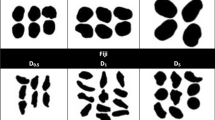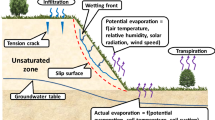Abstract
The mechanical behaviors of the interface between coarse-grained soil and concrete were investigated by simple shear tests under condition of mixed soil slurry (bentonite mixed with cement grout). For comparison, the interfaces both without slurry and with bentonite slurry were analyzed. The experimental results show that different slurries exert much influence on the strength and deformation of soil/structure interface. Under mixed soil slurry, strain softening and shear dilatation are observed, while shear dilatation appears under the small normal stress of the interface without slurry, and shear contraction is significant under the condition of the bentonite slurry. The thickness of the interface was determined by analyzing the disturbed height of the sample with both simple shear test and particle flow code (PFC). An elasto-plastic constitutive model incorporating strain softening and dilatancy for thin layer element of interface was formulated in the framework of generalized potential theory. The relation curves of shear stress and shear strain, as well as the relation curves of normal strain and shear strain, were fitted by a piecewise function composed by hyperbolic functions and resembling normal functions. The entire model parameters can be identified by tests. The new model is verified by comparing the measured data of indoor cut-off wall model tests with the predictions from finite element method (FEM). The FEM results indicate that the stress of wall calculated by using Goodman element is too large, and the maximum deviation between the test data and prediction is about 45%. While the prediction from the proposed model is close to the measured data, and the error is generally less than 10%.
Similar content being viewed by others
References
CLOUGH G W, DUNCAN J M. Finite element analysis of retaining wall behavior [J]. Journal of the Soil Mechanics and Foundations Division, ASCE, 1971, 97(SM12): 1657–1673.
BRANDT J R T. Behavior of soil concrete interfaces [D]. Edmonton, Canada: University of Alberta, 1985: 72–95.
KISHIDA H, UESUGI M. Tests of the interface between sand and steel in the simple shear apparatus [J]. Geotechnique, 1987, 37(1): 45–52.
GENS A, CAROL I, ALONSO E E. An interface element formulation for the analysis of soil-reinforcement interaction [J]. Computers and Geotechnics, 1988, 7(1): 133–151.
ZHANG Ga, ZHANG Jian-min. Experimental study on monotonic behavior of soil-structure interface with slurry [J]. Rock and Soil Mechanics, 2005, 26(9): 1 374–1 378. (in Chinese)
FROST J D, DEJONG J T, RECALDE M. Shear failure behavior of granular-continuum interfaces [J]. Engineering Fracture Mechanics, 2002, 69(17): 2029–2048.
HU Li-ming, PU Jia-liu. Testing and modeling of soil-structure interface [J]. Journal of Geotechnical and Geoenvironmental Engineering, 2004, 130(8): 851–860.
SAID I, GENNARO D V, FRANK R. Axisymmetric finite element analysis of pile loading test [J]. Computers and Geotechnics, 2009, 36(1/2): 6–19.
DOVE J E, JARRETT J B. Behavior of dilative sand interface in a Geotribology framework [J]. Journal of Geotechnical and Geoenvironmental Engineering, 2002, 128(1): 25–37.
ZEGHAL M, Tuncer B E. Soil structure interaction analysis: Modeling the interface [J]. Canadian Geotechnical Journal, 2002, 39: 620–628.
DEJONG J T, WESTGATE Z J. Role of over consolidation on sand-geomembrane interface response and material damage evolution [J]. Geotxtile sand Geomembranes, 2005, 23(6): 486–512.
MILLER G A, HAMID T B. Interface Direct shear testing of unsaturated soil [J]. Geotechnical Testing Journal, 2007, 30(3): 182–191.
TUNCER B E, PETER J B, AARON J S. Soil-structure interface shear transfer behavior [J]. Geomechanics ASCE, 2005: 528–543.
SHAKIR R R. Experimental study and numerical constitutive modeling of soil-concrete interaction [D]. Nanjing: Hohai University, Civil Engineering Department, 2009: 110–116.
BOULON M, PLYTAS C. Soil structure directionally dependent interface constitutive equations-application to the prediction of shaft friction along plies [C]// Proceedings of the Second International Symposium on Numerical Models in Geo-mechanics. Ghent, Belgium: 1986: 43–54.
DESAI C S, PRADHAN S K. Cyclic testing and constitutive modeling of saturated sand-concrete interfaces using the disturbed state concept [J]. International Journal of Geomechanics, 2005, 5(4): 286–294.
MORTARA G., BOULON M, GHIONNA V N. A 2D constitutive model for cyclic interface behavior [J]. Int J Numer Anal Meth Geomech, 2002, 26(11): 1071–1096.
GENNARO V, FRANK R. Elasto-plastic analysis of the international behavior between granular media and structure [J]. Computers and Geotechnics, 2002, 29: 547–572.
CABALLERO A, WILLAM K J, CAROL I. Consistent tangent formulation for 3D interface modeling of cracking/fracture in quasi-brittle materials [J]. Computer Methods in Applied Mechanics and Engineering, 2008, 197(33–40): 2804–2822.
PASTER M, ZIENKIEWICZ O C, CHAN A H C. Generalized plasticity and the modeling of soil behavior [J]. International Journal for Numerical and Analytical Methods in Geomechanics, 1990, 14(3): 151–190.
YANG Guang-hua. A new strain space elastopalstic constitutive model for soil [C]// Proceedings of Second International Conference on Soft Soil Engineering. Nanjing: Hohai University Press, 1996: 1–8.
YIN Zong-ze, ZHU Hong, XU Guo-hua. Numerical simulation of the deformation in the interface between soil and structure material [J]. Chinese Journal of Geotechnical Engineering, 1994, 16(3): 14–22. (in Chinese)
ZHANG Zhi-jun, RAO Xi-bao, WANG Zhi-jun, DING Hong-shun. Experimental study on influence of slurry thickness on mechanical behavior of interface between gravel and concrete [J]. Rock and Soil Mechanics, 2008, 29(9): 2433–2438. (in Chinese)
ZHANG Ga, ZHANG Jian-min. Three-dimensional model of interface between structure and coarse grained soil [J]. Rock and Soil Mechanics, 2007, 28(2): 288–292. (in Chinese)
ZHANG Miao-zhong, ZHANG Guang-xing, WU Qing-yong, XIN Gong-feng. Studies on characteristics of mudcake and soil between bored plies [J]. Chinese Journal of Geotechnical Engineering, 2006, 28(6): 695–699. (in Chinese)
PENG Kai, ZHU Zhu-gao, ZHANG Dan, WU Xiao-yu. Study of mechanical behaviors of interface between coarse-grained soil and concrete by simple shear tests [J]. Chinese Journal of Rock Mechanics and Engineering, 2010, 29(9): 1983–1990. (in Chinese)
THORNTON C, ZHANG L. A DEM comparison of different shear testing devices [C]// 4th International Conference on Micromechanics of Granular Media. Rotterdam, The Netherlands: 2001: 183–189.
POTYONDY D O, CUNDALL P A. A bonded-particle model for rock [J]. International Journal of Rock Mechanics Mining Sciences, 2004, 41: 1329–1364.
SEGUEL O, HORN R. Mechanical behavior of a volcanic ash soil under static and dynamic loading [J]. Soil and Tillage Research, 2005, 82(1): 109–116.
YANG Xiao-li, HUANG Fu. Collapse mechanism of shallow tunnel based on nonlinear Hoek-Brown failure criterion [J]. Tunnelling and Underground Space Technology, 2011, 26(6): 686–691.
YANG Xiao-li, WANG Jin-min. Ground movement prediction for tunnels using simplified procedure [J]. Tunnelling and Underground Space Technology, 2011, 26(3): 462–471.
YANG Xiao-li. Seismic passive pressures of earth structures by nonlinear optimization [J]. Archive of Applied Mechanics, 2011, 81(9): 1195–1202.
YANG Xiao-li, HUANG Fu, WANG Jin-min. Modified image analytical solutions for ground displacement using the nonuniform convergence model [J]. Journal of Central South University of Technology, 2011, 18(3): 859–865.
ZHOU Ai-zhao, LU Ting-hao. Elasto-plastic constitutive model of soil-structure interface in consideration of strain softening and dilation [J]. Acta Mechanics Solida Sinica, 2009, 22(2): 171–179.
Author information
Authors and Affiliations
Corresponding author
Additional information
Foundation item: Project(20110094110002) supported by the Specialized Research Fund for the Doctoral Program of Higher Education of China; Project(200801014) supported by the Ministry of Water Resources of China; Project(50825901) supported by the National Natural Science Foundation of China
Rights and permissions
About this article
Cite this article
Peng, K., Zhu, Jg., Feng, Sr. et al. An elasto-plastic constitutive model incorporating strain softening and dilatancy for interface thin-layer element and its verification. J. Cent. South Univ. 19, 1988–1998 (2012). https://doi.org/10.1007/s11771-012-1236-6
Received:
Accepted:
Published:
Issue Date:
DOI: https://doi.org/10.1007/s11771-012-1236-6




